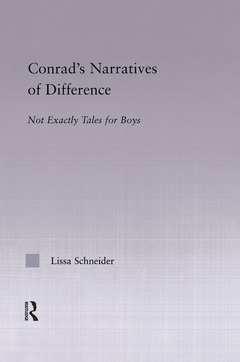Description
Conrad's Narratives of Difference
Not Exactly Tales for Boys
Studies in Major Literary Authors Series
Author: Schneider-Rebozo Lissa
Language: English
Keywords
Young Man; Winnie Verloc; Secret Sharer; Chief Inspector Heat; Conrad’s Writings; Domestic Drama; Sir Ethelred; Conrad’s Fictions; Comrade Ossipon; London’s Central Criminal Court; Conrad's Narratives; Misty Halos; Cl Iv; Manager’s Spy; James Wait; Marlow Tales; Conrad’s Attitudes; Assistant Commissioner; Twixt Land; Greenwich Park; Gentleman Brown; Secret Agent; Lady Patroness; African Mistress; Traditional Romance Plot
67.43 €
In Print (Delivery period: 14 days).
Add to cartPublication date: 06-2014
Support: Print on demand
Publication date: 10-2003
· 15.2x22.9 cm · Hardback
Description
/li>Contents
/li>Biography
/li>Comment
/li>
In Joseph Conrad?s tales, representations of women and of "feminine" generic forms like the romance are often present in fugitive ways. Conrad?s use of allegorical feminine imagery, fleet or deferred introductions of female characters, and hybrid generic structures that combine features of "masculine" tales of adventure and intrigue and "feminine" dramas of love or domesticity are among the subjects of this literary study. Many of Conrad?s critics have argued that Conrad?s fictions are aesthetically flawed by the inclusion of women and love plots; thus Thomas Moser has questioned why Conrad did not "cut them out altogether." Yet a thematics of gender suffuses Conrad?s narrative strategies. Even in tales that contain no significant female characters or obvious love plots, Conrad introduces elusive feminine presences, in relationships between men, as well as in men?s relationships to their ship, the sea, a shore breeze, or even in the gendered embrace of death. This book investigates an identifiably feminine "point of view" which is present in fugitive ways throughout Conrad?s canon. Conrad?s narrative strategies are articulated through a language of sexual difference that provides the vocabulary and grammar for tales examining European class, racial, and gender paradigms to provide acute and, at times, equivocal investigations of femininity and difference.
Introduction: Not Exactly Tales for Boys 1. Iconography and the Feminine Ideal: Torches, Blindfolds, and the "true light of femininity" in Heart of Darkness, Lord Jim, The Rescue, and "The Return" 2. Plots and Performance: Conrad's "tricks with girls" in "Freya of the Seven Isles," Under Western Eyes, An Outcast of the Islands, and The Rescue 3. Colonial Occupations: Race and Gender in "An Outpost of Progress" and The Nigger of the "Narcissus" 4. Politics in the House: Genre, Narrative, and the Domestic Drama in The Secret Agent, Heart of Darkness, and Lord Jim Coda: Narrative, Femininity, Death
Lissa Schneider-Rebozo is Associate Professor of English and Director of Undergraduate Research, Scholarly, and Creative Activity at University of Wisconsin, River Falls, USA.
These books may interest you

The Secret AgentA Simple Tale 47.09 €

The Secret AgentA Simple Tale 91.52 €


